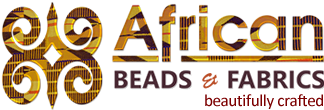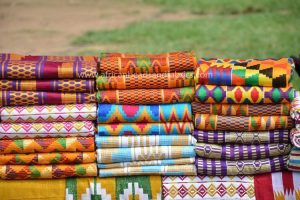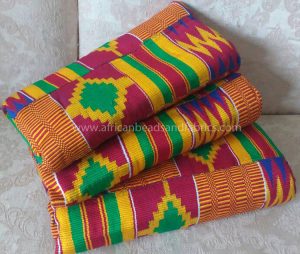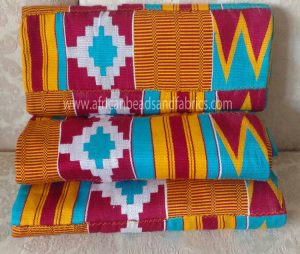Kente Weaving
The art of kente weaving is difficult to describe using words only. We have therefore produced a video demonstrating the technique which we hope you will find time to watch.
In the past locally grown cotton has been spun and dyed with naturally occurring local materials but in recent times imported yarn has overtaken the local yarn as the major raw material for kente weaving.
Commonly used material include rayon, silk and metallic yarn which gives the final product a shimmery finish.
A number of processes are followed in kente production including warp laying, threading and weaving. The entire process is very detailed and complicated and beyond the scope of this work. We have tried to summarise the process in this article.
More detailed descriptions can be found in Ross (1998). We have also produced a video which we hope will make the process easier to understand.
- cotton yarn used for kente weaving
- laying the warp
- preparing the loom
Equipment
- wooden loom
- shuttles
- heddles
- beaters
Spinning
In the past the first step in kente weaving was yarn spinning using the skein winder and bobbin winder. However in recent times the yarn is purchased on the bobbin so this step is no longer required.
Warp Laying
This sets the background for the fabric to be woven.
Bobbins are placed on the warp layer or bobbin carrier (menkomenam) and enough warp is laid for 24 strips which is enough for a full size male kente cloth.
According to Ross (1998) the warp is laid by walking between two poles placed about 30 metres apart. A third pole is placed about 25 cm from the starting point. At the end of each lap round the second pole, each thread is passed between the first and third pole, crossed over itself and then taken to the second pole.
The weaver’s cross is set up in the correct order to establish the desired pattern.
Threading
This refers to the process by which the yarn is passed through the heddles and beater in preparation for weaving. Done manually, it is xtremely tedious and time consuming.
However this has to be done correctly to ensure that the right pattern is woven.
The number of heddles used would vary between two to six depending on the complexity of the pattern to be woven. For a simple weave two heddles are used and alternate threads are passed through each heddle in turn.
The treads are then passed through the beater (or reed) and secured to the breast beam.
Each of the above pairs of heddles is secured to its colleague with a cord that passes through a pulley. The cord is connected to a toehold made of old rubber sandals which the weaver uses to raise and lower the pairs of heddles.
Finally the shuttles are threaded with yarn. Additional threads are cut for hand-picked inlays
Weaving
Weaving takes place on portable wooden loom built on a narrow base knows as Nsadua Kofi.
Three different weaving patterns are described:
- Simple weave: This is the simplest weave for the beginner to master. This is woven using a single pair of heddles
- Double weave: this contains a pattern but the background is seen in it. It may require two or three pairs of heddles to weave.
- Triple weave is the most complex and requires mastery of the art of weaving. It is also the most time consuming and this is reflected in the price of the woven fabric. It is often accomplished by hand weaving without use of the shuttle.
The typical kente patterns consists of alternating complex and simple weave patterns.
- weavers tend to be male
- many young male weavers are learning the trade
- some women are defying tradition and taking up the trade
Weaving Process
The weaver sits on a low stool at the open end of the loom and puts the toeholds between his/ her toes. For simple weave they raise and lower the asatia heddles (further away from them) in alternate sequence by pulling down on alternate toe-holds and passing the shuttle through the space (shed) that is created. After a number of passes of the shuttle the weaver will pull the reed (beater) towards themself to pack down the threads.
He uses the measuring stick (susudua) to measure the desired length of plain weave and then proceeds to the more complex parts of the fabric.
Ross refers to the design element of the weave is referred as Babadua (probably similar to double weave). To do this the weaver transfers his toe-hold to the asanan heddles and multi-coloured bands of weave are created using the shuttle.
The most complicated part of the weave is the adwen section (likely similar to triple weave). This involved hand picking with the shuttle used to maintain the ground of the cloth. Supplementary weft is inserted by laying double weft thread between the ground thread. The heddles are usually pulled down by hand during this stage.
The measuring stick is used to determine the length of each of the above sections.
Once a section of adwen is completed, another section of babadua is done before returning to plain weave.
When a strip is completed the next strip will begin a different pattern is order to get the alternating adwen/ babadua/adwen pattern which is characteristic of kente cloth.
The entire cloth is woven as one piece and then cut into individual strips which are then sewn together to get the completed kente cloth.
Kente weaving is traditionally done by men, although one will find a few women kente weavers when visiting the kente weaving areas. Women tend to concentrate on the sewing of the strips together as well as marketing of the final product and the materials used for kente production.
You can access our kente weaving video by using this link. (coming later :))
Sewing The Strips Together
The Final Product
Kente cloth is made in different sizes for male and female users. The male cloth is made up of (24 to 30) strips sewn together and has a final size of 128 x 85 inches. You will find some smaller or slightly bigger but always large enough for use by men. The cloth for women comes normally comes in a set of three made up of strips usually 4-5 inches wide and about 60-70 inches long. Each finished piece is approximately two yards long but as they are different widths (32 to 42 inches), you couldn’t say they were exactly two yards each, although some sellers will advertise them as such.
- kente cloth comes in a myriad of largely bright colours
- a row of popup stalls
- more and more contemporary colours are available
- modern colours
- traditional kente colours
- combination of tradtional and modern
Reference
Ross DH (1998): Ghanaian Kente and African American Identity: UCLA Fowler Museum of Cultural History.
Our Stock
Tempted? Examples of the fabric we stock can be found on our web site www.africanbeadsandfabrics.com or Etsy store KenteFabricShop. Some of the fabrics we carry:
- traditional kente cloth































